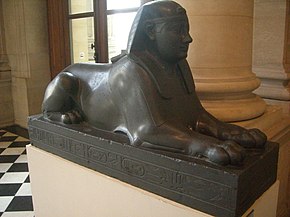Nepherites I.
| Names of Nepherites I. | |||||||||||||||||
|---|---|---|---|---|---|---|---|---|---|---|---|---|---|---|---|---|---|
| Horus name |
ˁ3-jb With great understanding |
||||||||||||||||
| Gold name |
Stp-nṯrw chosen of the gods |
||||||||||||||||
| Throne name |
B3-n-Rˁ-mrj-nṯrw Ba- Soul of Re , lover of the gods |
||||||||||||||||
| Proper name |
(Naief aau rud [u]) N3yf ˁ3w rwḏ (w) His greats are permanent |
||||||||||||||||
| Sphinx Nepherites' I .; Louvre , Paris | |||||||||||||||||
Nepherites I , also Nefaarud I , was the founder and first pharaoh (king) of the 29th dynasty , the "four kings of Mendes" ( Manetho ).
Domination
Nepherites I seized in the autumn of 399 BC The power and had his predecessor Amyrtaios captured and executed. This is what it says in an Aramaic papyrus (Papyrus Brooklyn 13). He was crowned in Memphis or Sais . After that he resided in Sais or Mendes . In terms of foreign policy, it should be mentioned that he supported Sparta in the war against Persia . He supplied 500,000 bushels of grain and the equipment for 100 trireme . However, he did not participate militarily.
Domestically, his construction activity is primarily attested. In Mendes himself (now Tell er-Rubsa, Tell Temai) was in 1869 a Uschebti found the Nepherites I., who was together with other meager remains of a burial in a sarcophagus of black granite, which was embedded in an outer limestone sarcophagus. Presumably it was his funeral. The fragment of a granite gate and blocks of the Thott temple also come from Mendes. A statue of the Pharaoh is known from Buto . A basalt sphinx (now in the Louvre ) perhaps originally came from Memphis . In Middle and Upper Egypt , Nepherites I is attested above all in Karnak (perhaps the start of construction of the chapel of Achoris ; sacrificial magazines in the south of the Holy Lake; various blocks), as well as through a naos built in the White Monastery of Sohag . A priest of a statue of Nepherites I is known from Achmim . Only private monuments can be dated to his reign, such as four serapeum steles from Saqqara (where a faience plaque comes from; year 2) and a mummy bandage with demotic inscription (year 4).
Perhaps Nektanebos , the founder of the 30th Dynasty , ultimately descended from Nepherites I.
Possible grave
Archaeologists from the University of Toronto and Washington discovered a grave in Mendes in 1992/93 that could possibly be attributed to Nepherites. In the tomb there was a shabti with the name of the king; however, there is no ultimate proof of the allocation of the grave. Although it contained other additions and a large limestone sarcophagus, it is believed that it was found by the Persians in 343 BC. Was destroyed. Ceramic vases with wrapped bodies of fish and steles with depictions of fish were also found in the grave complex. These are interpreted as votive offerings and could indicate an earlier temple of the fish goddess Hatmehit .
literature
- Peter A. Clayton : The Pharaohs. Weltbild, Augsburg 1998, ISBN 3-8289-0661-3 , pp. 201-202.
- Leo Depuydt : Saite and Persian Egypt, 664 BC-332 BC (Dyns. 26-31, Psammetichus I to Alexander's Conquest of Egypt). In: Erik Hornung, Rolf Krauss, David A. Warburton (eds.): Ancient Egyptian Chronology (= Handbook of Oriental studies. Section One. The Near and Middle East. Volume 83). Brill, Leiden / Boston 2006, ISBN 978-90-04-11385-5 , pp. 265-283 ( online ).
- Aidan Dodson , Dyan Hilton : The Complete Royal Families of Ancient Egypt. Thames & Hudson, London 2004, ISBN 0-500-05128-3 , p. 254.
- Thomas Schneider : Lexicon of the Pharaohs. Albatros, Düsseldorf 2002, ISBN 3-491-96053-3 , p. 179.
Web links
- Jona Lendering: Nepherites I . In: Livius.org (English)
Individual evidence
- ^ A b Dieter Arnold: Temples of the last Pharaohs . Oxford University Press, Oxford, UK 1999, ISBN 978-0-19-512633-4 , p. 102.
- ^ Aidan Dodson: The Canopic Equipment of the Kings of Egypt (= Studies in Egyptology ). Kegan Paul International, London 1994 / Routledge, Oxford UK 2009, ISBN 978-0-7103-0460-5 , Chapter 6.
- ↑ Christina Riggs (Ed.): The Oxford Handbook of Roman Egypt . Oxford University Press, Oxford, UK 2012, ISBN 978-0-19-957145-1 , p. 34, (accessed June 7, 2017).
| predecessor | Office | successor |
|---|---|---|
| Amyrtaios |
Pharaoh of Egypt 399–393 BC Chr. |
Muthis |
| personal data | |
|---|---|
| SURNAME | Nepherites I. |
| BRIEF DESCRIPTION | 1st Pharaoh of the 29th Dynasty |
| DATE OF BIRTH | 5th century BC Chr. |
| DATE OF DEATH | 393 BC Chr. |


